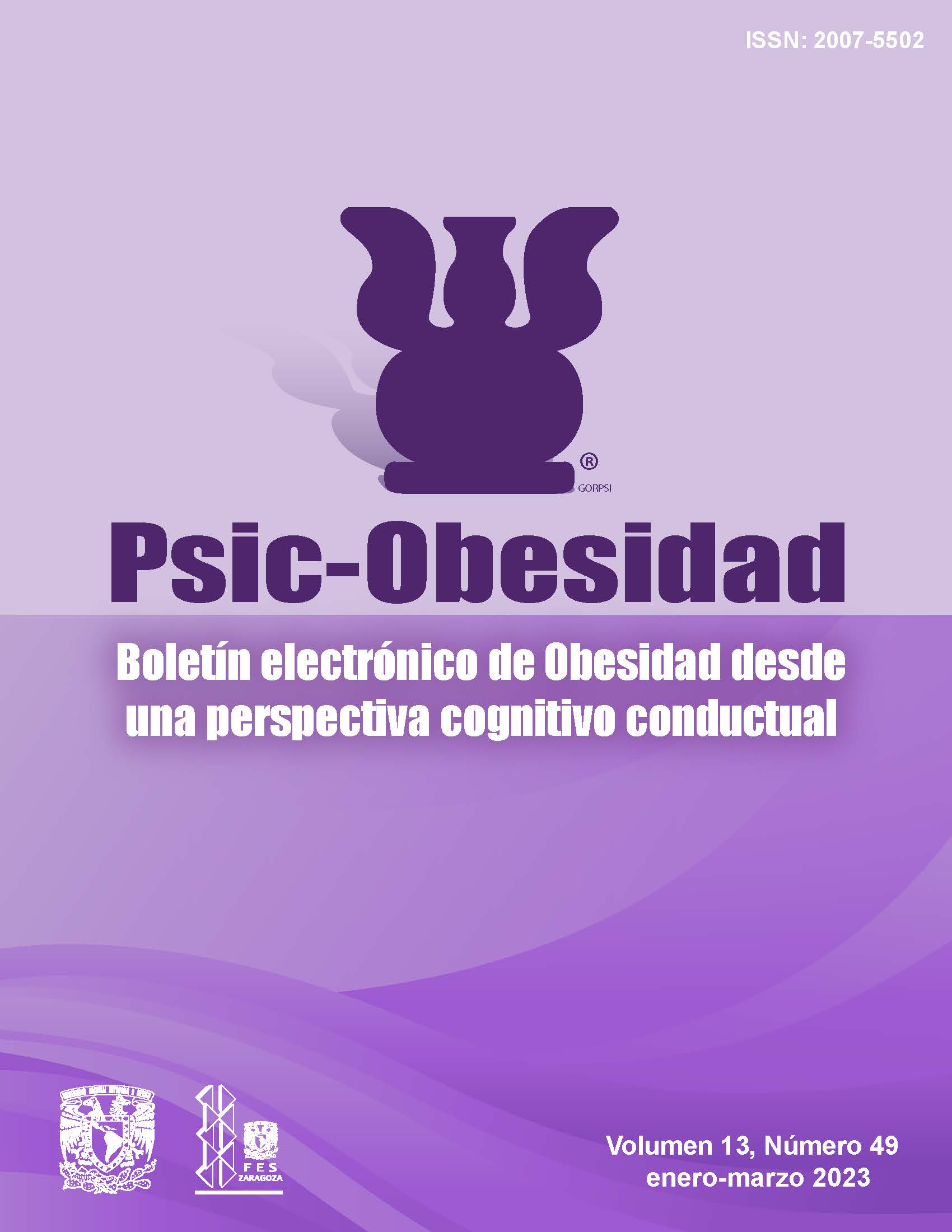Obesity and stress at work: beyond binge eating
Main Article Content
Abstract
Mexico has a standard on work and related psychosocial risk factors, its method of identification, analysis and its prevention, NOM, 035-STPS, 2018. Its focus is environmental and on interpersonal relationships, related to well-being in general and for conditions conducive to the good performance of work teams that result in optimal performance, cordial relationships, healthy integral health status and good management of work pressure. On the contrary, negative relationships at work have repercussions on integral wellbeing: in abnormal cognitions and behaviors, predominance of negative emotions; in the physical-bodily with metabolic changes of risk to other diseases such as mental and body weight condition. The relationship between obesity and work stress has been studied mainly from the clinical, social, labor and educational fields, due to the repercussions in each area. This paper reviews the concepts of work, stress, work stress and their relationship with overweight and obesity presented by the scientific literature. It provides lines of approach to study the relationship between obesity, working conditions and stress.
Downloads
Article Details
Citas en Dimensions Service
References
Bakker, A. B., & Demerouti, E. (2018). Multiple levels in job demandsresources theory: Implications for employee well-being and performance. In E. Diener, S. Oishi, y L. Tay (Eds.), Handbook of wellbeing. DEF Publishers.
Barría-González, J., Postigo, A., Pérez-Luco, R., Cuesta, M., & García-Cueto, E. (2021). Evaluación de Clima Organizacional: Propiedades psicométricas del ECALS. Anales de psicología, 37(1), 168 - 177. https://doi.org/10.6018/analesps.417571
Cooper, M.L., Sloan, S.J., & Williams, S. (1988). The occupational stress indicator. Windsor: NFER Nelson.
Gutiérrez R, Á.Y. (2012). Estrés organizacional. Trillas.
Hakanen, J. J., Seppälä, P., & Peeters, M. C. W. (2017). High job demands, still engaged and not burned out? The role of job crafting. International Journal of Behavioral Medicine, 24(4), 619–627. doi: 10.1007/s12529-017-9638-3
Kumar, R., Rizvi, M. R., & Saraswat, S. (2022). Obesity and Stress: A Contingent Paralysis. Int J Prev Med, 24, 13. doi: 10.4103/ijpvm.IJPVM_427_20.
Martínez-Gárate, I., Valdés-del-Olmo, L., Bayona-González, A., y Martínez-Castellanos, J.A. (2021). Relación entre la obesidad y el estrés laboral: una revisión sistemática. Med. segur. trab, 67(263), 112-127. https://dx.doi.org/10.4321/s0465-546x2021000200004.
Medina-Aguilar, S., Preciado-Serrano, M. L., y Pando-Moreno, M. (2007). Adaptación de la escala de estrés laboral organizacional para trabajadores mexicanos. Revista de Salud Pública y Nutrición, 8(4), https://respyn.uanl.mx/index.php/respyn/article/view/197
Norma Oficial Mexicana NOM-035-STPS-2018. https://dof.gob.mx/nota_detalle.php?codigo=5541828&fecha=23%2F10%2F2018
Organización Internacional del Trabajo (OIT) (1996-2017). ¿Qué es el trabajo decente? https://www.ilo.org/americas/sala-de-prensa/WCMS_LIM_653_SP/lang--es/index.htm
Organización Internacional del Trabajo (OIT) (2016). Estrés en el trabajo: Un reto colectivo. Servicio de Administración del Trabajo, Inspección del Trabajo y Seguridad y Salud en el Trabajo - LABADMIN/OSH. OIT, 2016. https://www.ilo.org/wcmsp5/groups/public/---americas/---ro-lima/documents/genericdocument/wcms_475146.pdf.
Patlán-Pérez, J. (2019). ¿Qué es el estrés laboral y cómo medirlo? Salud Uninorte, 35(1), 156 - 184. scielo.org.co/pdf/sun/v35n1/2011-7531-sun-35-01-156.pdf
Patlán-Pérez, J. (2022). Construcción y validación de una Escala Demanda-Control-Apoyo para medir el estrés laboral Revista Médica Herediana, 33(1), 24-36. https://doi.org/10.20453/rmh.v33i1.4165
Pimentel-Araujo, M. A., Villarreal-Ríos, E., Galicia-Rodríguez, L., & Vargas-Daza, E. R. (2021). Factores laborales asociados a sobrepeso y obesidad en adultos jóvenes. Rev Asoc Esp Espec Med Trab, 30(3), 263-379. https://scielo.isciii.es/pdf/medtra/v30n3/1132-6255-medtra-30-03-318.pdf.
Santana-Cárdenas, S. (2016). Relación del estrés laboral con la conducta alimentaria y la obesidad: Consideraciones teóricas y empíricas. Revista mexicana de trastornos alimentarios, 7(2). Versión On-line. https://doi.org/10.1016/j.rmta.2016.07.002
Steiler, D., Cooper, G. L. (2004). Short Communication: French versión of the Occupational Stress Indicator (OSI): preliminary assessment of reliability and validity. Str Hea. 20, 231-237. doi: http://dx.doi.org/ 10.1002/smi.1018
Steiler, D., & Rosnet, E. (2011). La mesure du stress professionnel. Différentes méthodologies de recueil. Rev Sci Gest, Direc Gest. 251, 71-79. doi: http://dx.doi.org/ 10.3917/rsg.251.0071
Wanjek, Ch. (2005). La alimentación en el trabajo (Food at Work: Workplace solutions for malnutrition, obesity and chronic diseases). www.ilo.org/public/spanish/bureau/inf/download/s_foodatwork.pdf. https://www.ilo.org/global/about-the-ilo/newsroom/news/WCMS_006116/lang--es/index.htm
